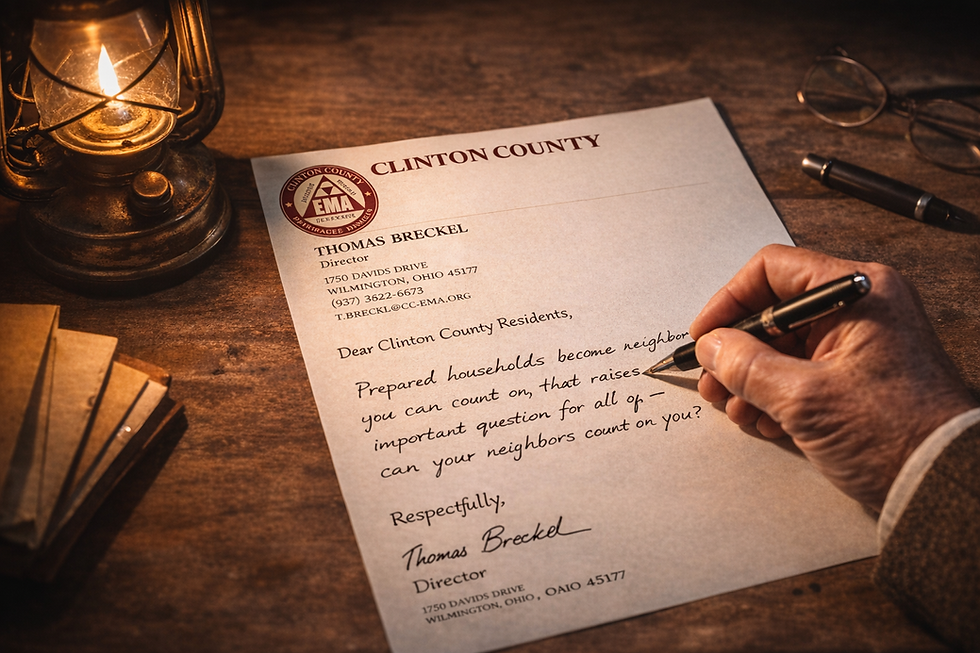Know Clinton County’s Top Risks
- Thomas Breckel

- Aug 31, 2025
- 3 min read

September is National Preparedness Month, and the first step toward being ready is understanding the hazards that threaten our community. Every county has unique risks, shaped by its geography, infrastructure, and history. Clinton County is no different.
According to the 2025 Clinton County Hazard Mitigation Plan, local officials and community stakeholders identified and ranked hazards based on their likelihood and potential impact. Here’s what rises to the top for our area:
Clinton County’s Highest-Priority Hazards
Utility Failure – Power outages, communication breakdowns, and water system failures can happen during storms or equipment issues. These disruptions affect everything from emergency response to daily life.
Tornadoes and Severe Wind – We’re no strangers to strong storms. High winds can damage homes, farms, and infrastructure in minutes.
Severe Winter Weather – Snow, ice, and extreme cold can shut down roads, threaten power supplies, and put vulnerable residents at risk.
Hazardous Materials – With major highways and rail lines running through our county, spills and accidents involving chemicals are a real concern.
Flooding – Heavy rains can cause creeks and low-lying areas to overflow, damaging property and cutting off access to rural communities.
Other hazards—such as drought, epidemics, wildfires, and even earthquakes—rank lower, but they are still monitored and included in county planning efforts.
How You Can Rank Hazards for Your Household
Understanding countywide hazards is important, but preparedness becomes personal when you take the time to look at your own household risks. Here’s a simple step-by-step process:
1. Make a Hazard List
Write down the hazards most likely to affect you. Start with the top county risks above, then add anything unique to your location. Examples:
Live near a creek or floodplain? Add flooding.
Rely on a well or medical equipment? Add utility failure and power outages.
Commute daily along major highways or rail crossings? Include hazardous materials transport.
2. Score Each Hazard
Use the same method local officials used: give each hazard a score of 0–5 for likelihood (how often it might happen) and 0–5 for impact (how much it would affect your family).
Example: Tornadoes may be “Likely (4)” but you have a basement for shelter, so the “Impact” is Moderate (3). Score = 7.
Example: Flooding may be “Unlikely (1)” for your location but “High Impact (5)” if it happens. Score = 6.
3. Rank Your Hazards
Add the scores together and order them from highest to lowest. The top three hazards on your list should guide your family’s preparedness efforts.
4. Talk It Over
Sit down as a family and make sure everyone understands what the top risks are. Kids and teens may have different concerns (like tornado sirens or power outages affecting school), and their input matters.
5. Match Plans to Risks
If power outages rank highest → Invest in backup batteries, generators, and extra water.
If tornadoes rank highest → Identify your safest shelter spot and practice getting there quickly.
If hazmat accidents rank high → Talk about shelter-in-place steps (closing windows, shutting off HVAC).
Why This Matters
When residents understand local risks, they’re better able to prepare. That might mean storing backup supplies, trimming trees near power lines, checking flood insurance, or signing up for Clinton County Emergency Alerts.
Preparedness starts with awareness—and knowing what hazards we face makes every other step easier. Ready Rex reminds us: “You can’t prepare if you don’t know what you’re up against!” 🦖
- - - END - - -
September is National Preparedness Month—a nationwide campaign to raise awareness about the importance of being ready for disasters and emergencies. It’s the perfect opportunity to take simple steps that strengthen your household’s safety, security, and resilience all year long.






Comments